Research Methods in HRM: Employee Motivation and Performance
VerifiedAdded on 2023/01/12
|12
|2971
|38
Report
AI Summary
This report examines the impact of Human Resource Management (HRM) practices on employee motivation and performance, specifically within the context of Morrison's retail sector. The research aims to identify how HRM strategies influence employee motivation and performance levels, while also assessing the challenges in implementing these practices. The report includes a literature review covering the scope of HRM, its impact on employee development, and the challenges faced by HR departments such as legal and ethical considerations, cost management, and cultural variations. The methodology involves an interpretivism philosophy, employing both primary (interviews) and secondary data collection methods. The report also outlines sampling techniques, data analysis using thematic analysis, and addresses validity and reliability, along with research limitations. It concludes with recommendations for improving HRM practices to enhance employee motivation and performance in Morrison's.
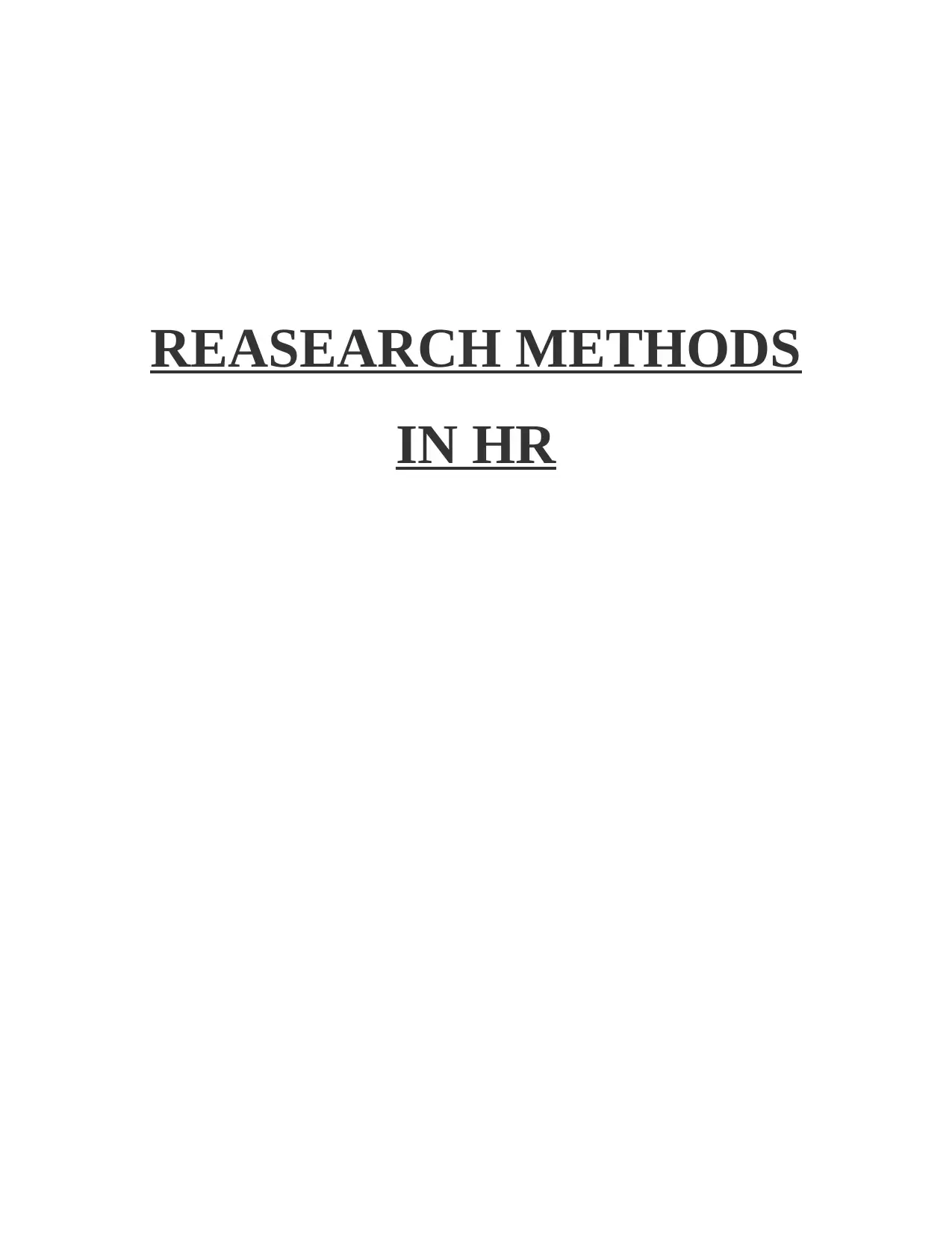
REASEARCH METHODS
IN HR
IN HR
Paraphrase This Document
Need a fresh take? Get an instant paraphrase of this document with our AI Paraphraser
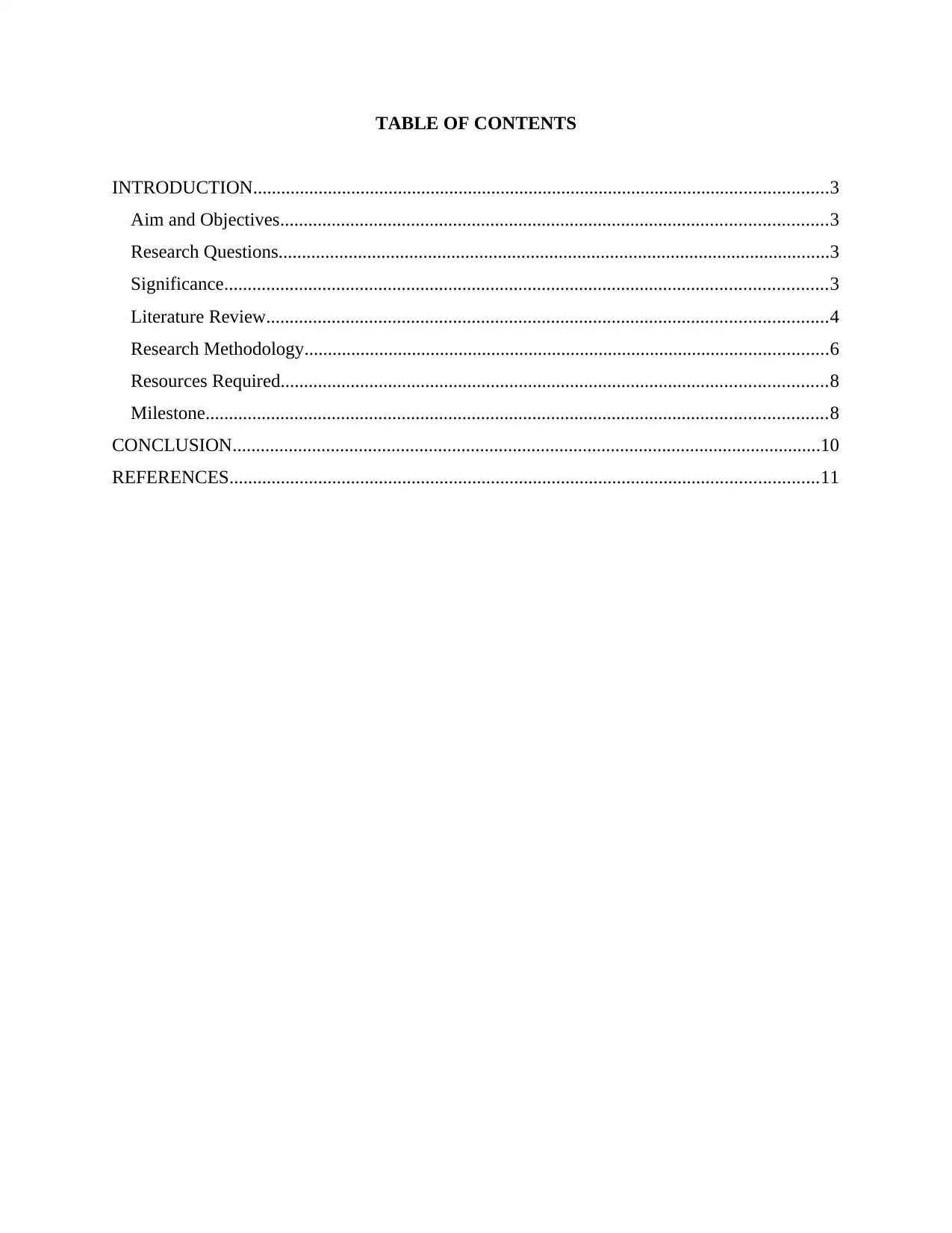
TABLE OF CONTENTS
INTRODUCTION...........................................................................................................................3
Aim and Objectives.....................................................................................................................3
Research Questions......................................................................................................................3
Significance.................................................................................................................................3
Literature Review........................................................................................................................4
Research Methodology................................................................................................................6
Resources Required.....................................................................................................................8
Milestone.....................................................................................................................................8
CONCLUSION..............................................................................................................................10
REFERENCES..............................................................................................................................11
INTRODUCTION...........................................................................................................................3
Aim and Objectives.....................................................................................................................3
Research Questions......................................................................................................................3
Significance.................................................................................................................................3
Literature Review........................................................................................................................4
Research Methodology................................................................................................................6
Resources Required.....................................................................................................................8
Milestone.....................................................................................................................................8
CONCLUSION..............................................................................................................................10
REFERENCES..............................................................................................................................11
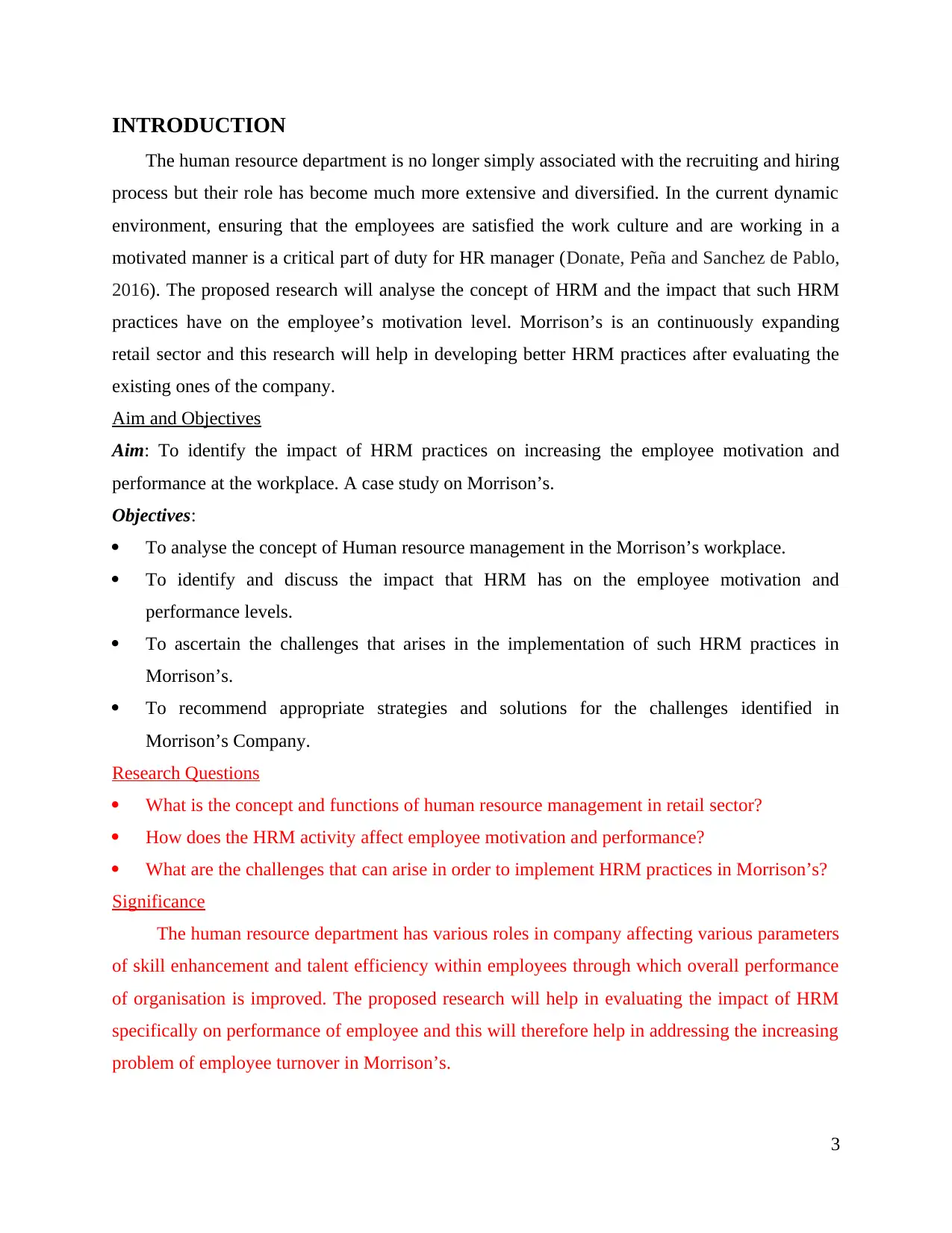
INTRODUCTION
The human resource department is no longer simply associated with the recruiting and hiring
process but their role has become much more extensive and diversified. In the current dynamic
environment, ensuring that the employees are satisfied the work culture and are working in a
motivated manner is a critical part of duty for HR manager (Donate, Peña and Sanchez de Pablo,
2016). The proposed research will analyse the concept of HRM and the impact that such HRM
practices have on the employee’s motivation level. Morrison’s is an continuously expanding
retail sector and this research will help in developing better HRM practices after evaluating the
existing ones of the company.
Aim and Objectives
Aim: To identify the impact of HRM practices on increasing the employee motivation and
performance at the workplace. A case study on Morrison’s.
Objectives:
To analyse the concept of Human resource management in the Morrison’s workplace.
To identify and discuss the impact that HRM has on the employee motivation and
performance levels.
To ascertain the challenges that arises in the implementation of such HRM practices in
Morrison’s.
To recommend appropriate strategies and solutions for the challenges identified in
Morrison’s Company.
Research Questions
What is the concept and functions of human resource management in retail sector?
How does the HRM activity affect employee motivation and performance?
What are the challenges that can arise in order to implement HRM practices in Morrison’s?
Significance
The human resource department has various roles in company affecting various parameters
of skill enhancement and talent efficiency within employees through which overall performance
of organisation is improved. The proposed research will help in evaluating the impact of HRM
specifically on performance of employee and this will therefore help in addressing the increasing
problem of employee turnover in Morrison’s.
3
The human resource department is no longer simply associated with the recruiting and hiring
process but their role has become much more extensive and diversified. In the current dynamic
environment, ensuring that the employees are satisfied the work culture and are working in a
motivated manner is a critical part of duty for HR manager (Donate, Peña and Sanchez de Pablo,
2016). The proposed research will analyse the concept of HRM and the impact that such HRM
practices have on the employee’s motivation level. Morrison’s is an continuously expanding
retail sector and this research will help in developing better HRM practices after evaluating the
existing ones of the company.
Aim and Objectives
Aim: To identify the impact of HRM practices on increasing the employee motivation and
performance at the workplace. A case study on Morrison’s.
Objectives:
To analyse the concept of Human resource management in the Morrison’s workplace.
To identify and discuss the impact that HRM has on the employee motivation and
performance levels.
To ascertain the challenges that arises in the implementation of such HRM practices in
Morrison’s.
To recommend appropriate strategies and solutions for the challenges identified in
Morrison’s Company.
Research Questions
What is the concept and functions of human resource management in retail sector?
How does the HRM activity affect employee motivation and performance?
What are the challenges that can arise in order to implement HRM practices in Morrison’s?
Significance
The human resource department has various roles in company affecting various parameters
of skill enhancement and talent efficiency within employees through which overall performance
of organisation is improved. The proposed research will help in evaluating the impact of HRM
specifically on performance of employee and this will therefore help in addressing the increasing
problem of employee turnover in Morrison’s.
3
⊘ This is a preview!⊘
Do you want full access?
Subscribe today to unlock all pages.

Trusted by 1+ million students worldwide
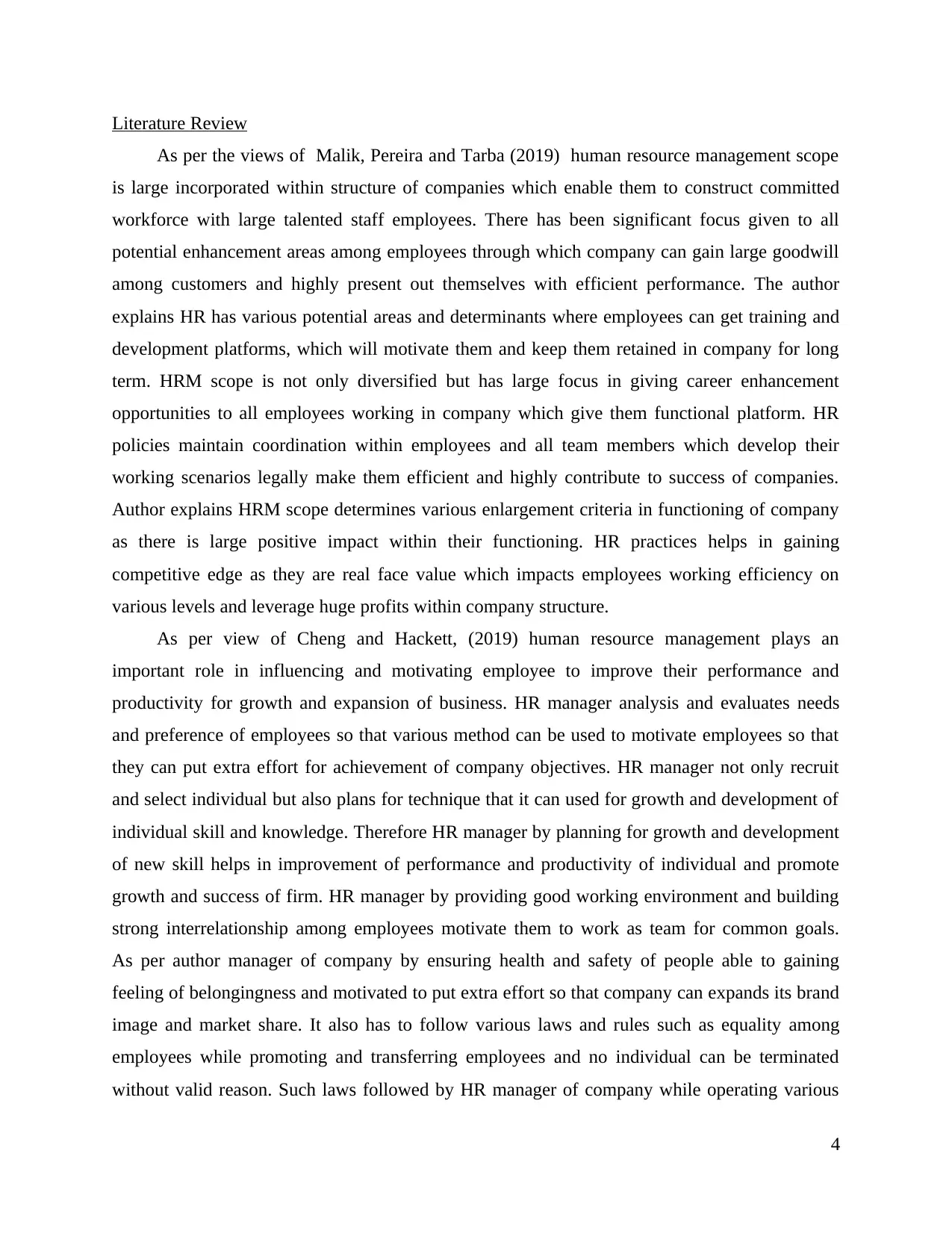
Literature Review
As per the views of Malik, Pereira and Tarba (2019) human resource management scope
is large incorporated within structure of companies which enable them to construct committed
workforce with large talented staff employees. There has been significant focus given to all
potential enhancement areas among employees through which company can gain large goodwill
among customers and highly present out themselves with efficient performance. The author
explains HR has various potential areas and determinants where employees can get training and
development platforms, which will motivate them and keep them retained in company for long
term. HRM scope is not only diversified but has large focus in giving career enhancement
opportunities to all employees working in company which give them functional platform. HR
policies maintain coordination within employees and all team members which develop their
working scenarios legally make them efficient and highly contribute to success of companies.
Author explains HRM scope determines various enlargement criteria in functioning of company
as there is large positive impact within their functioning. HR practices helps in gaining
competitive edge as they are real face value which impacts employees working efficiency on
various levels and leverage huge profits within company structure.
As per view of Cheng and Hackett, (2019) human resource management plays an
important role in influencing and motivating employee to improve their performance and
productivity for growth and expansion of business. HR manager analysis and evaluates needs
and preference of employees so that various method can be used to motivate employees so that
they can put extra effort for achievement of company objectives. HR manager not only recruit
and select individual but also plans for technique that it can used for growth and development of
individual skill and knowledge. Therefore HR manager by planning for growth and development
of new skill helps in improvement of performance and productivity of individual and promote
growth and success of firm. HR manager by providing good working environment and building
strong interrelationship among employees motivate them to work as team for common goals.
As per author manager of company by ensuring health and safety of people able to gaining
feeling of belongingness and motivated to put extra effort so that company can expands its brand
image and market share. It also has to follow various laws and rules such as equality among
employees while promoting and transferring employees and no individual can be terminated
without valid reason. Such laws followed by HR manager of company while operating various
4
As per the views of Malik, Pereira and Tarba (2019) human resource management scope
is large incorporated within structure of companies which enable them to construct committed
workforce with large talented staff employees. There has been significant focus given to all
potential enhancement areas among employees through which company can gain large goodwill
among customers and highly present out themselves with efficient performance. The author
explains HR has various potential areas and determinants where employees can get training and
development platforms, which will motivate them and keep them retained in company for long
term. HRM scope is not only diversified but has large focus in giving career enhancement
opportunities to all employees working in company which give them functional platform. HR
policies maintain coordination within employees and all team members which develop their
working scenarios legally make them efficient and highly contribute to success of companies.
Author explains HRM scope determines various enlargement criteria in functioning of company
as there is large positive impact within their functioning. HR practices helps in gaining
competitive edge as they are real face value which impacts employees working efficiency on
various levels and leverage huge profits within company structure.
As per view of Cheng and Hackett, (2019) human resource management plays an
important role in influencing and motivating employee to improve their performance and
productivity for growth and expansion of business. HR manager analysis and evaluates needs
and preference of employees so that various method can be used to motivate employees so that
they can put extra effort for achievement of company objectives. HR manager not only recruit
and select individual but also plans for technique that it can used for growth and development of
individual skill and knowledge. Therefore HR manager by planning for growth and development
of new skill helps in improvement of performance and productivity of individual and promote
growth and success of firm. HR manager by providing good working environment and building
strong interrelationship among employees motivate them to work as team for common goals.
As per author manager of company by ensuring health and safety of people able to gaining
feeling of belongingness and motivated to put extra effort so that company can expands its brand
image and market share. It also has to follow various laws and rules such as equality among
employees while promoting and transferring employees and no individual can be terminated
without valid reason. Such laws followed by HR manager of company while operating various
4
Paraphrase This Document
Need a fresh take? Get an instant paraphrase of this document with our AI Paraphraser
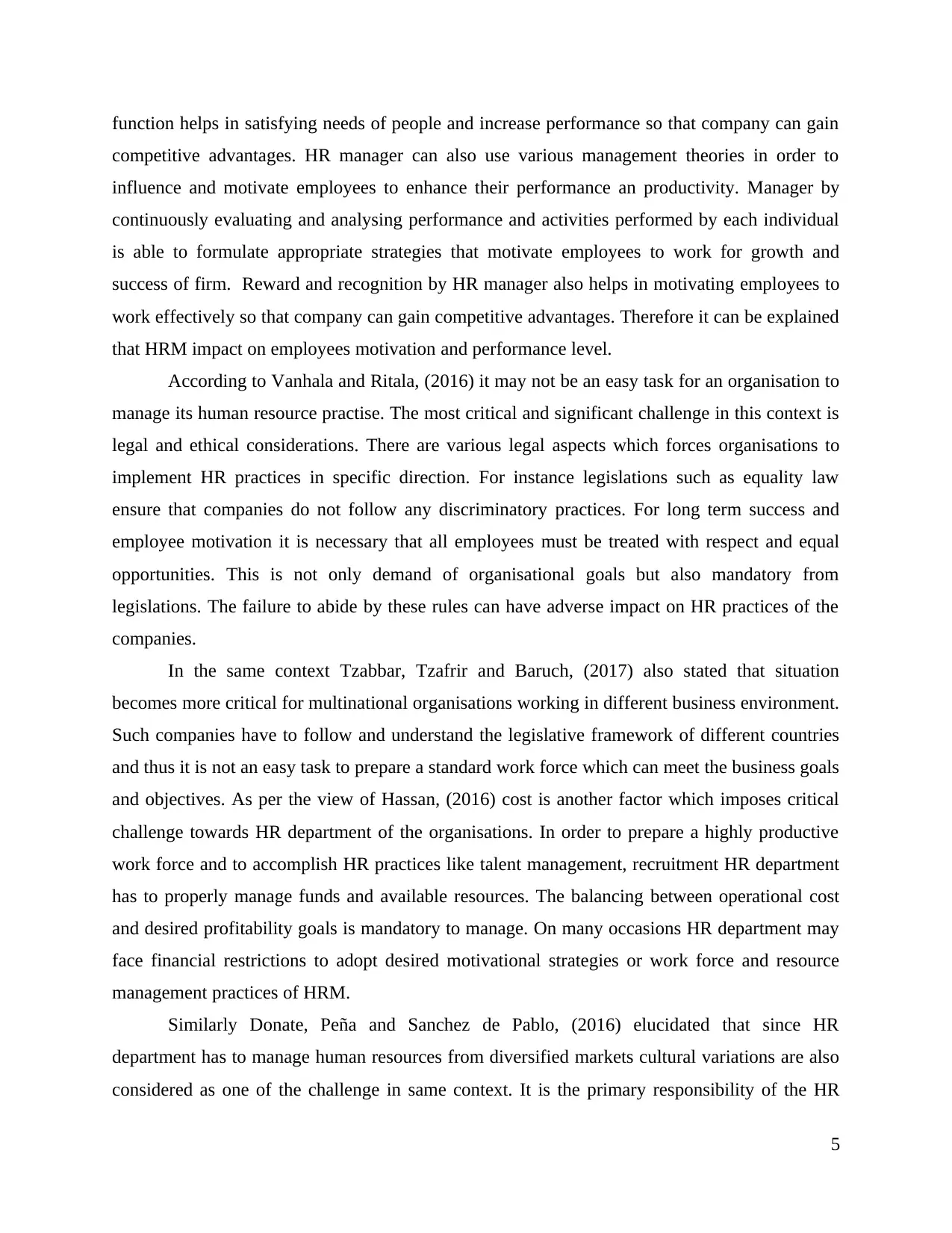
function helps in satisfying needs of people and increase performance so that company can gain
competitive advantages. HR manager can also use various management theories in order to
influence and motivate employees to enhance their performance an productivity. Manager by
continuously evaluating and analysing performance and activities performed by each individual
is able to formulate appropriate strategies that motivate employees to work for growth and
success of firm. Reward and recognition by HR manager also helps in motivating employees to
work effectively so that company can gain competitive advantages. Therefore it can be explained
that HRM impact on employees motivation and performance level.
According to Vanhala and Ritala, (2016) it may not be an easy task for an organisation to
manage its human resource practise. The most critical and significant challenge in this context is
legal and ethical considerations. There are various legal aspects which forces organisations to
implement HR practices in specific direction. For instance legislations such as equality law
ensure that companies do not follow any discriminatory practices. For long term success and
employee motivation it is necessary that all employees must be treated with respect and equal
opportunities. This is not only demand of organisational goals but also mandatory from
legislations. The failure to abide by these rules can have adverse impact on HR practices of the
companies.
In the same context Tzabbar, Tzafrir and Baruch, (2017) also stated that situation
becomes more critical for multinational organisations working in different business environment.
Such companies have to follow and understand the legislative framework of different countries
and thus it is not an easy task to prepare a standard work force which can meet the business goals
and objectives. As per the view of Hassan, (2016) cost is another factor which imposes critical
challenge towards HR department of the organisations. In order to prepare a highly productive
work force and to accomplish HR practices like talent management, recruitment HR department
has to properly manage funds and available resources. The balancing between operational cost
and desired profitability goals is mandatory to manage. On many occasions HR department may
face financial restrictions to adopt desired motivational strategies or work force and resource
management practices of HRM.
Similarly Donate, Peña and Sanchez de Pablo, (2016) elucidated that since HR
department has to manage human resources from diversified markets cultural variations are also
considered as one of the challenge in same context. It is the primary responsibility of the HR
5
competitive advantages. HR manager can also use various management theories in order to
influence and motivate employees to enhance their performance an productivity. Manager by
continuously evaluating and analysing performance and activities performed by each individual
is able to formulate appropriate strategies that motivate employees to work for growth and
success of firm. Reward and recognition by HR manager also helps in motivating employees to
work effectively so that company can gain competitive advantages. Therefore it can be explained
that HRM impact on employees motivation and performance level.
According to Vanhala and Ritala, (2016) it may not be an easy task for an organisation to
manage its human resource practise. The most critical and significant challenge in this context is
legal and ethical considerations. There are various legal aspects which forces organisations to
implement HR practices in specific direction. For instance legislations such as equality law
ensure that companies do not follow any discriminatory practices. For long term success and
employee motivation it is necessary that all employees must be treated with respect and equal
opportunities. This is not only demand of organisational goals but also mandatory from
legislations. The failure to abide by these rules can have adverse impact on HR practices of the
companies.
In the same context Tzabbar, Tzafrir and Baruch, (2017) also stated that situation
becomes more critical for multinational organisations working in different business environment.
Such companies have to follow and understand the legislative framework of different countries
and thus it is not an easy task to prepare a standard work force which can meet the business goals
and objectives. As per the view of Hassan, (2016) cost is another factor which imposes critical
challenge towards HR department of the organisations. In order to prepare a highly productive
work force and to accomplish HR practices like talent management, recruitment HR department
has to properly manage funds and available resources. The balancing between operational cost
and desired profitability goals is mandatory to manage. On many occasions HR department may
face financial restrictions to adopt desired motivational strategies or work force and resource
management practices of HRM.
Similarly Donate, Peña and Sanchez de Pablo, (2016) elucidated that since HR
department has to manage human resources from diversified markets cultural variations are also
considered as one of the challenge in same context. It is the primary responsibility of the HR
5
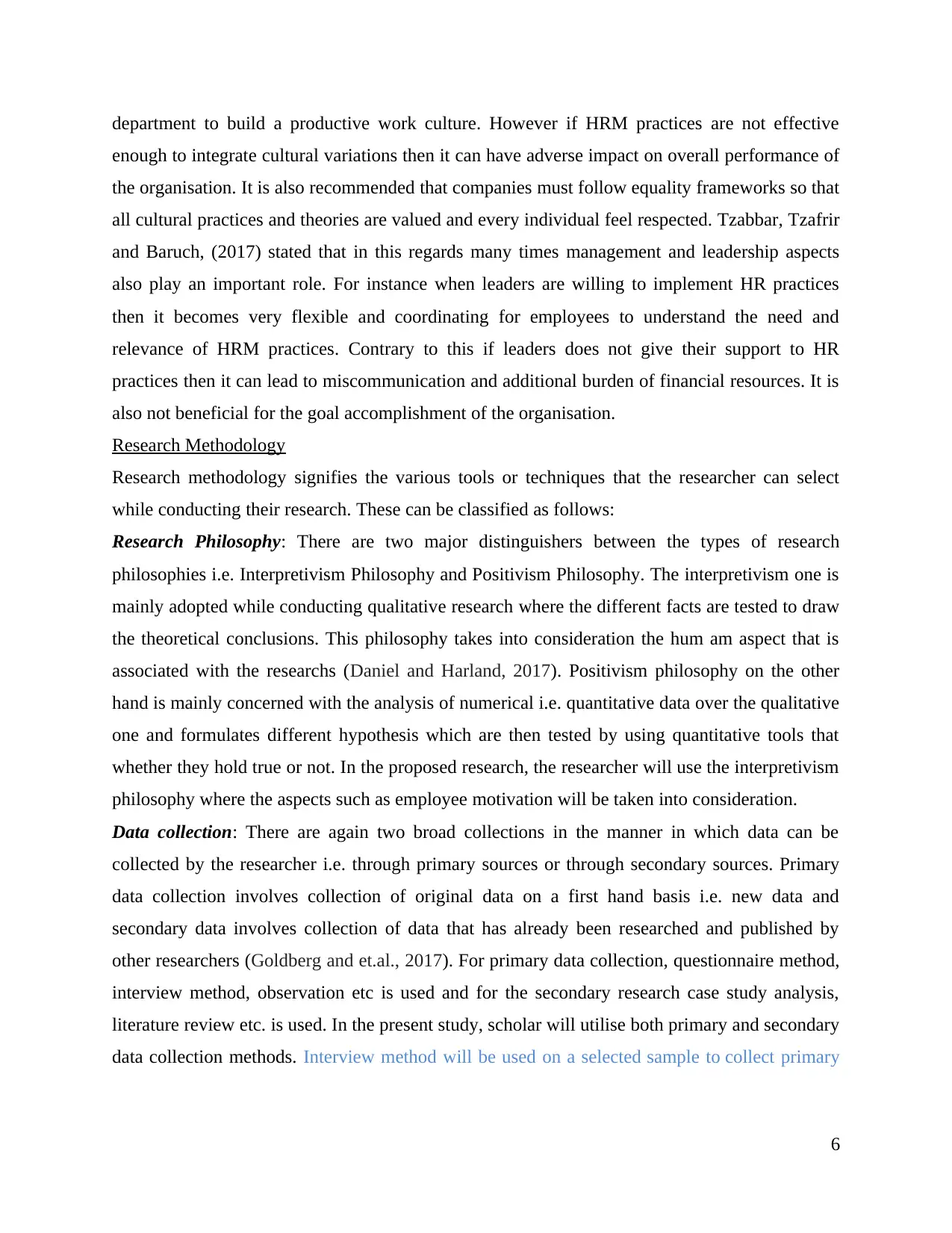
department to build a productive work culture. However if HRM practices are not effective
enough to integrate cultural variations then it can have adverse impact on overall performance of
the organisation. It is also recommended that companies must follow equality frameworks so that
all cultural practices and theories are valued and every individual feel respected. Tzabbar, Tzafrir
and Baruch, (2017) stated that in this regards many times management and leadership aspects
also play an important role. For instance when leaders are willing to implement HR practices
then it becomes very flexible and coordinating for employees to understand the need and
relevance of HRM practices. Contrary to this if leaders does not give their support to HR
practices then it can lead to miscommunication and additional burden of financial resources. It is
also not beneficial for the goal accomplishment of the organisation.
Research Methodology
Research methodology signifies the various tools or techniques that the researcher can select
while conducting their research. These can be classified as follows:
Research Philosophy: There are two major distinguishers between the types of research
philosophies i.e. Interpretivism Philosophy and Positivism Philosophy. The interpretivism one is
mainly adopted while conducting qualitative research where the different facts are tested to draw
the theoretical conclusions. This philosophy takes into consideration the hum am aspect that is
associated with the researchs (Daniel and Harland, 2017). Positivism philosophy on the other
hand is mainly concerned with the analysis of numerical i.e. quantitative data over the qualitative
one and formulates different hypothesis which are then tested by using quantitative tools that
whether they hold true or not. In the proposed research, the researcher will use the interpretivism
philosophy where the aspects such as employee motivation will be taken into consideration.
Data collection: There are again two broad collections in the manner in which data can be
collected by the researcher i.e. through primary sources or through secondary sources. Primary
data collection involves collection of original data on a first hand basis i.e. new data and
secondary data involves collection of data that has already been researched and published by
other researchers (Goldberg and et.al., 2017). For primary data collection, questionnaire method,
interview method, observation etc is used and for the secondary research case study analysis,
literature review etc. is used. In the present study, scholar will utilise both primary and secondary
data collection methods. Interview method will be used on a selected sample to collect primary
6
enough to integrate cultural variations then it can have adverse impact on overall performance of
the organisation. It is also recommended that companies must follow equality frameworks so that
all cultural practices and theories are valued and every individual feel respected. Tzabbar, Tzafrir
and Baruch, (2017) stated that in this regards many times management and leadership aspects
also play an important role. For instance when leaders are willing to implement HR practices
then it becomes very flexible and coordinating for employees to understand the need and
relevance of HRM practices. Contrary to this if leaders does not give their support to HR
practices then it can lead to miscommunication and additional burden of financial resources. It is
also not beneficial for the goal accomplishment of the organisation.
Research Methodology
Research methodology signifies the various tools or techniques that the researcher can select
while conducting their research. These can be classified as follows:
Research Philosophy: There are two major distinguishers between the types of research
philosophies i.e. Interpretivism Philosophy and Positivism Philosophy. The interpretivism one is
mainly adopted while conducting qualitative research where the different facts are tested to draw
the theoretical conclusions. This philosophy takes into consideration the hum am aspect that is
associated with the researchs (Daniel and Harland, 2017). Positivism philosophy on the other
hand is mainly concerned with the analysis of numerical i.e. quantitative data over the qualitative
one and formulates different hypothesis which are then tested by using quantitative tools that
whether they hold true or not. In the proposed research, the researcher will use the interpretivism
philosophy where the aspects such as employee motivation will be taken into consideration.
Data collection: There are again two broad collections in the manner in which data can be
collected by the researcher i.e. through primary sources or through secondary sources. Primary
data collection involves collection of original data on a first hand basis i.e. new data and
secondary data involves collection of data that has already been researched and published by
other researchers (Goldberg and et.al., 2017). For primary data collection, questionnaire method,
interview method, observation etc is used and for the secondary research case study analysis,
literature review etc. is used. In the present study, scholar will utilise both primary and secondary
data collection methods. Interview method will be used on a selected sample to collect primary
6
⊘ This is a preview!⊘
Do you want full access?
Subscribe today to unlock all pages.

Trusted by 1+ million students worldwide
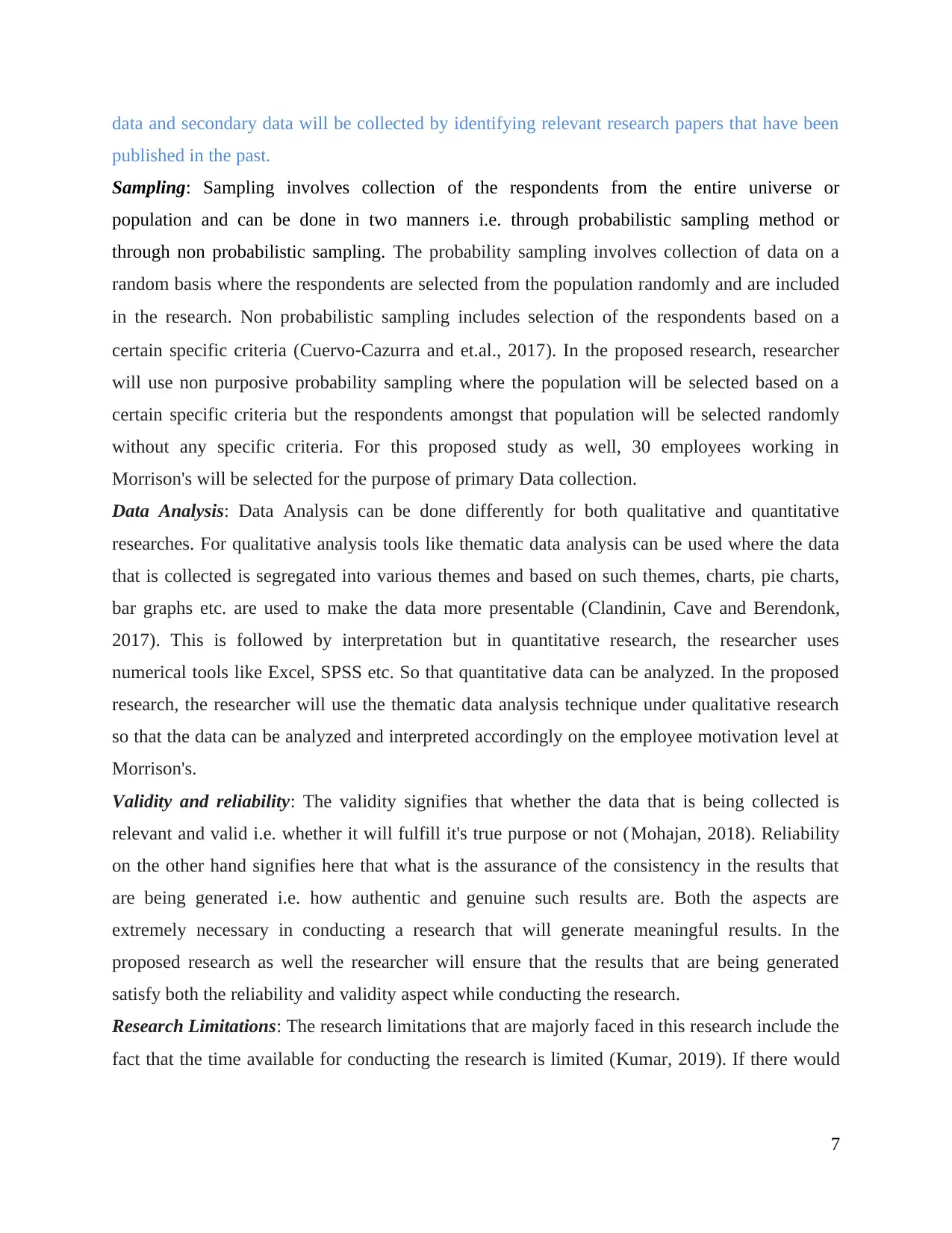
data and secondary data will be collected by identifying relevant research papers that have been
published in the past.
Sampling: Sampling involves collection of the respondents from the entire universe or
population and can be done in two manners i.e. through probabilistic sampling method or
through non probabilistic sampling. The probability sampling involves collection of data on a
random basis where the respondents are selected from the population randomly and are included
in the research. Non probabilistic sampling includes selection of the respondents based on a
certain specific criteria (Cuervo‐Cazurra and et.al., 2017). In the proposed research, researcher
will use non purposive probability sampling where the population will be selected based on a
certain specific criteria but the respondents amongst that population will be selected randomly
without any specific criteria. For this proposed study as well, 30 employees working in
Morrison's will be selected for the purpose of primary Data collection.
Data Analysis: Data Analysis can be done differently for both qualitative and quantitative
researches. For qualitative analysis tools like thematic data analysis can be used where the data
that is collected is segregated into various themes and based on such themes, charts, pie charts,
bar graphs etc. are used to make the data more presentable (Clandinin, Cave and Berendonk,
2017). This is followed by interpretation but in quantitative research, the researcher uses
numerical tools like Excel, SPSS etc. So that quantitative data can be analyzed. In the proposed
research, the researcher will use the thematic data analysis technique under qualitative research
so that the data can be analyzed and interpreted accordingly on the employee motivation level at
Morrison's.
Validity and reliability: The validity signifies that whether the data that is being collected is
relevant and valid i.e. whether it will fulfill it's true purpose or not (Mohajan, 2018). Reliability
on the other hand signifies here that what is the assurance of the consistency in the results that
are being generated i.e. how authentic and genuine such results are. Both the aspects are
extremely necessary in conducting a research that will generate meaningful results. In the
proposed research as well the researcher will ensure that the results that are being generated
satisfy both the reliability and validity aspect while conducting the research.
Research Limitations: The research limitations that are majorly faced in this research include the
fact that the time available for conducting the research is limited (Kumar, 2019). If there would
7
published in the past.
Sampling: Sampling involves collection of the respondents from the entire universe or
population and can be done in two manners i.e. through probabilistic sampling method or
through non probabilistic sampling. The probability sampling involves collection of data on a
random basis where the respondents are selected from the population randomly and are included
in the research. Non probabilistic sampling includes selection of the respondents based on a
certain specific criteria (Cuervo‐Cazurra and et.al., 2017). In the proposed research, researcher
will use non purposive probability sampling where the population will be selected based on a
certain specific criteria but the respondents amongst that population will be selected randomly
without any specific criteria. For this proposed study as well, 30 employees working in
Morrison's will be selected for the purpose of primary Data collection.
Data Analysis: Data Analysis can be done differently for both qualitative and quantitative
researches. For qualitative analysis tools like thematic data analysis can be used where the data
that is collected is segregated into various themes and based on such themes, charts, pie charts,
bar graphs etc. are used to make the data more presentable (Clandinin, Cave and Berendonk,
2017). This is followed by interpretation but in quantitative research, the researcher uses
numerical tools like Excel, SPSS etc. So that quantitative data can be analyzed. In the proposed
research, the researcher will use the thematic data analysis technique under qualitative research
so that the data can be analyzed and interpreted accordingly on the employee motivation level at
Morrison's.
Validity and reliability: The validity signifies that whether the data that is being collected is
relevant and valid i.e. whether it will fulfill it's true purpose or not (Mohajan, 2018). Reliability
on the other hand signifies here that what is the assurance of the consistency in the results that
are being generated i.e. how authentic and genuine such results are. Both the aspects are
extremely necessary in conducting a research that will generate meaningful results. In the
proposed research as well the researcher will ensure that the results that are being generated
satisfy both the reliability and validity aspect while conducting the research.
Research Limitations: The research limitations that are majorly faced in this research include the
fact that the time available for conducting the research is limited (Kumar, 2019). If there would
7
Paraphrase This Document
Need a fresh take? Get an instant paraphrase of this document with our AI Paraphraser
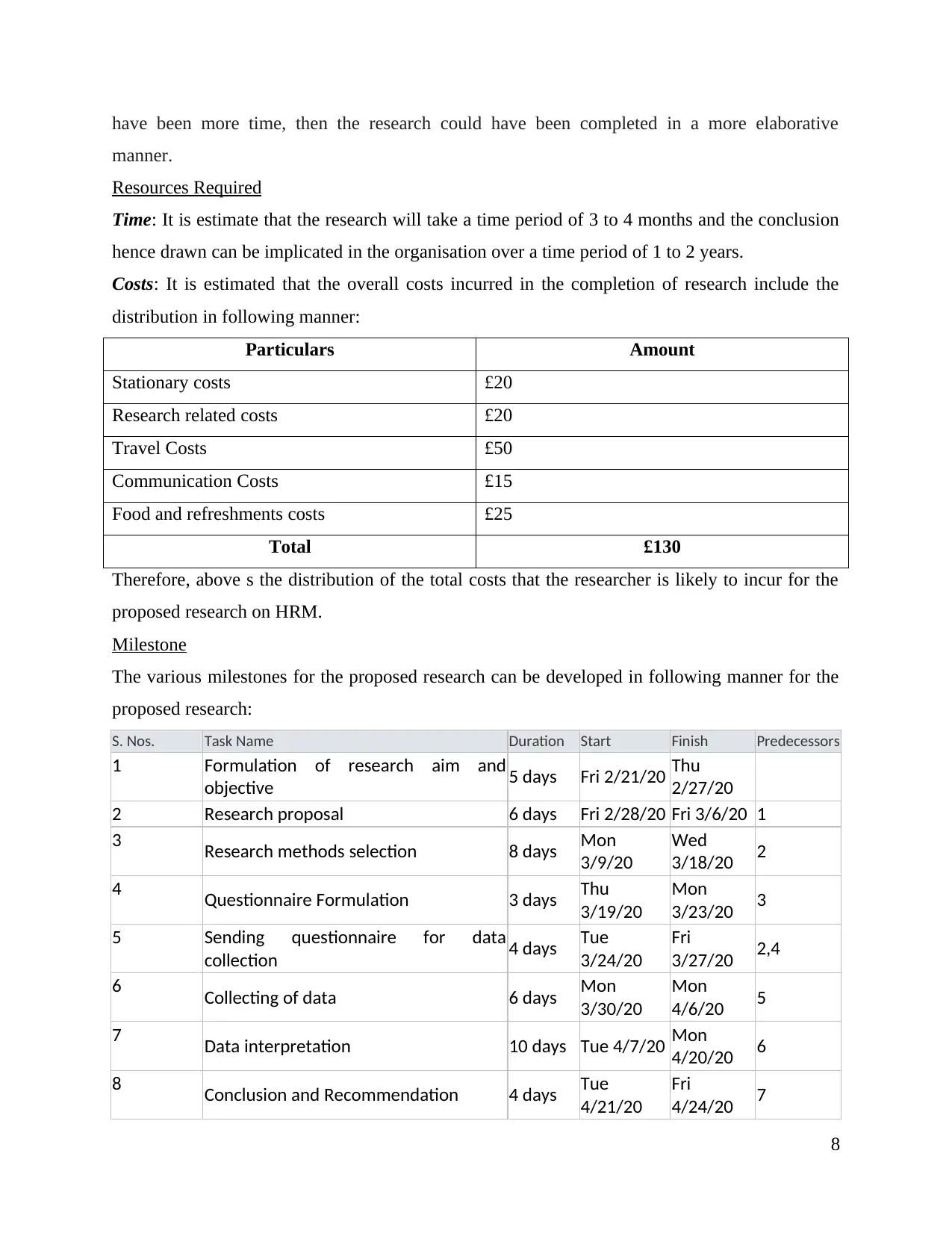
have been more time, then the research could have been completed in a more elaborative
manner.
Resources Required
Time: It is estimate that the research will take a time period of 3 to 4 months and the conclusion
hence drawn can be implicated in the organisation over a time period of 1 to 2 years.
Costs: It is estimated that the overall costs incurred in the completion of research include the
distribution in following manner:
Particulars Amount
Stationary costs £20
Research related costs £20
Travel Costs £50
Communication Costs £15
Food and refreshments costs £25
Total £130
Therefore, above s the distribution of the total costs that the researcher is likely to incur for the
proposed research on HRM.
Milestone
The various milestones for the proposed research can be developed in following manner for the
proposed research:
S. Nos. Task Name Duration Start Finish Predecessors
1 Formulation of research aim and
objective 5 days Fri 2/21/20 Thu
2/27/20
2 Research proposal 6 days Fri 2/28/20 Fri 3/6/20 1
3 Research methods selection 8 days Mon
3/9/20
Wed
3/18/20 2
4 Questionnaire Formulation 3 days Thu
3/19/20
Mon
3/23/20 3
5 Sending questionnaire for data
collection 4 days Tue
3/24/20
Fri
3/27/20 2,4
6 Collecting of data 6 days Mon
3/30/20
Mon
4/6/20 5
7 Data interpretation 10 days Tue 4/7/20 Mon
4/20/20 6
8 Conclusion and Recommendation 4 days Tue
4/21/20
Fri
4/24/20 7
8
manner.
Resources Required
Time: It is estimate that the research will take a time period of 3 to 4 months and the conclusion
hence drawn can be implicated in the organisation over a time period of 1 to 2 years.
Costs: It is estimated that the overall costs incurred in the completion of research include the
distribution in following manner:
Particulars Amount
Stationary costs £20
Research related costs £20
Travel Costs £50
Communication Costs £15
Food and refreshments costs £25
Total £130
Therefore, above s the distribution of the total costs that the researcher is likely to incur for the
proposed research on HRM.
Milestone
The various milestones for the proposed research can be developed in following manner for the
proposed research:
S. Nos. Task Name Duration Start Finish Predecessors
1 Formulation of research aim and
objective 5 days Fri 2/21/20 Thu
2/27/20
2 Research proposal 6 days Fri 2/28/20 Fri 3/6/20 1
3 Research methods selection 8 days Mon
3/9/20
Wed
3/18/20 2
4 Questionnaire Formulation 3 days Thu
3/19/20
Mon
3/23/20 3
5 Sending questionnaire for data
collection 4 days Tue
3/24/20
Fri
3/27/20 2,4
6 Collecting of data 6 days Mon
3/30/20
Mon
4/6/20 5
7 Data interpretation 10 days Tue 4/7/20 Mon
4/20/20 6
8 Conclusion and Recommendation 4 days Tue
4/21/20
Fri
4/24/20 7
8
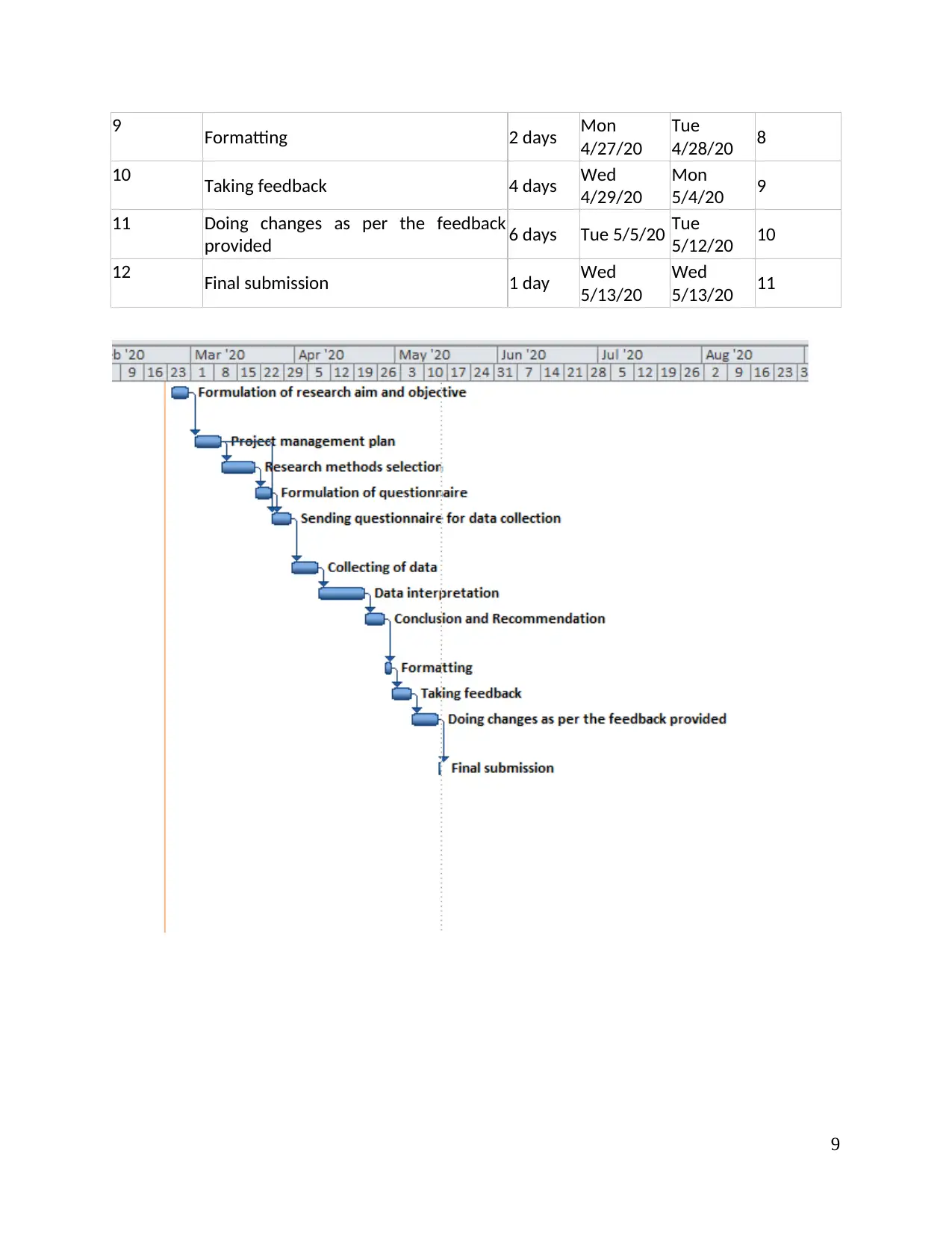
9 Formatting 2 days Mon
4/27/20
Tue
4/28/20 8
10 Taking feedback 4 days Wed
4/29/20
Mon
5/4/20 9
11 Doing changes as per the feedback
provided 6 days Tue 5/5/20 Tue
5/12/20 10
12 Final submission 1 day Wed
5/13/20
Wed
5/13/20 11
9
4/27/20
Tue
4/28/20 8
10 Taking feedback 4 days Wed
4/29/20
Mon
5/4/20 9
11 Doing changes as per the feedback
provided 6 days Tue 5/5/20 Tue
5/12/20 10
12 Final submission 1 day Wed
5/13/20
Wed
5/13/20 11
9
⊘ This is a preview!⊘
Do you want full access?
Subscribe today to unlock all pages.

Trusted by 1+ million students worldwide
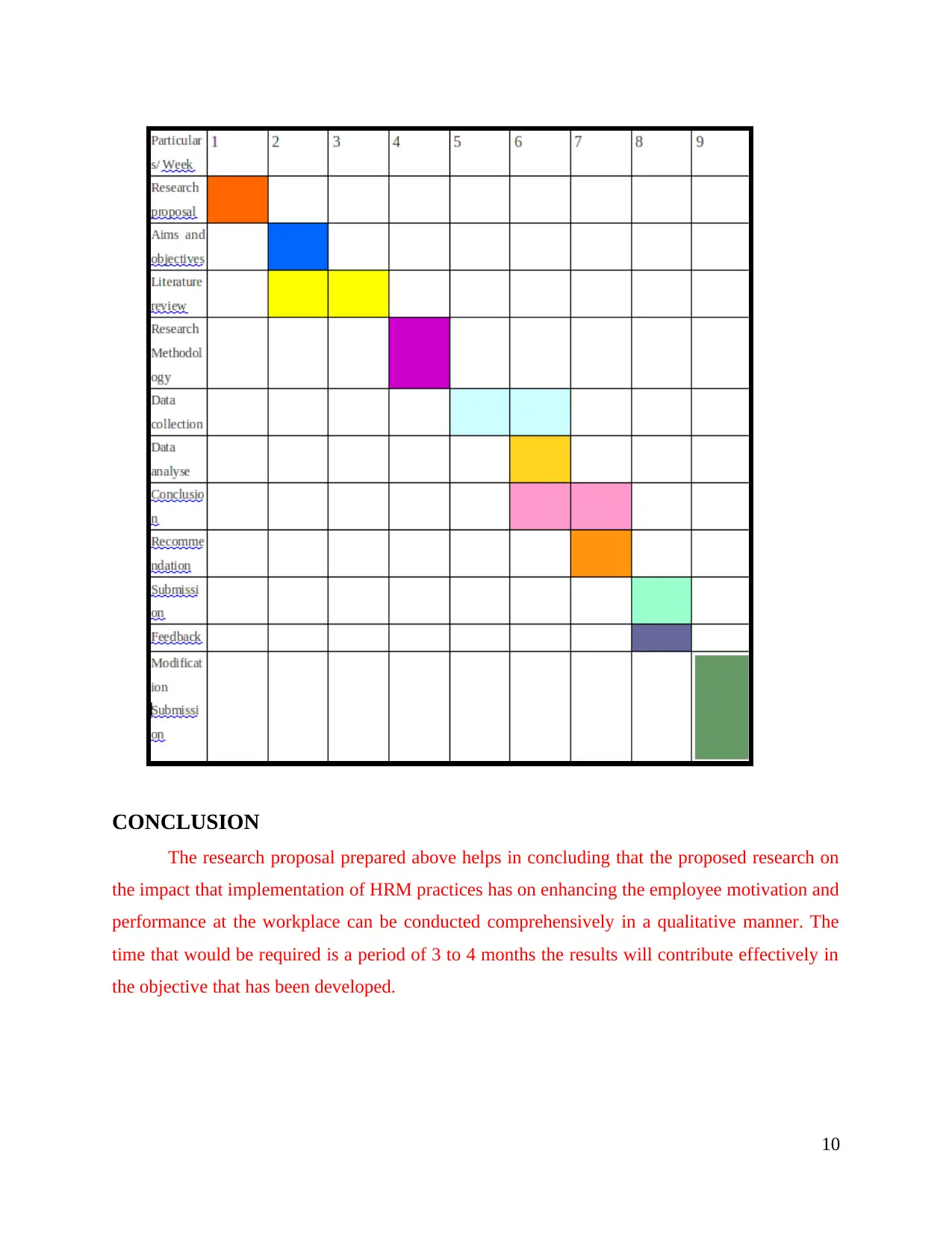
CONCLUSION
The research proposal prepared above helps in concluding that the proposed research on
the impact that implementation of HRM practices has on enhancing the employee motivation and
performance at the workplace can be conducted comprehensively in a qualitative manner. The
time that would be required is a period of 3 to 4 months the results will contribute effectively in
the objective that has been developed.
10
The research proposal prepared above helps in concluding that the proposed research on
the impact that implementation of HRM practices has on enhancing the employee motivation and
performance at the workplace can be conducted comprehensively in a qualitative manner. The
time that would be required is a period of 3 to 4 months the results will contribute effectively in
the objective that has been developed.
10
Paraphrase This Document
Need a fresh take? Get an instant paraphrase of this document with our AI Paraphraser
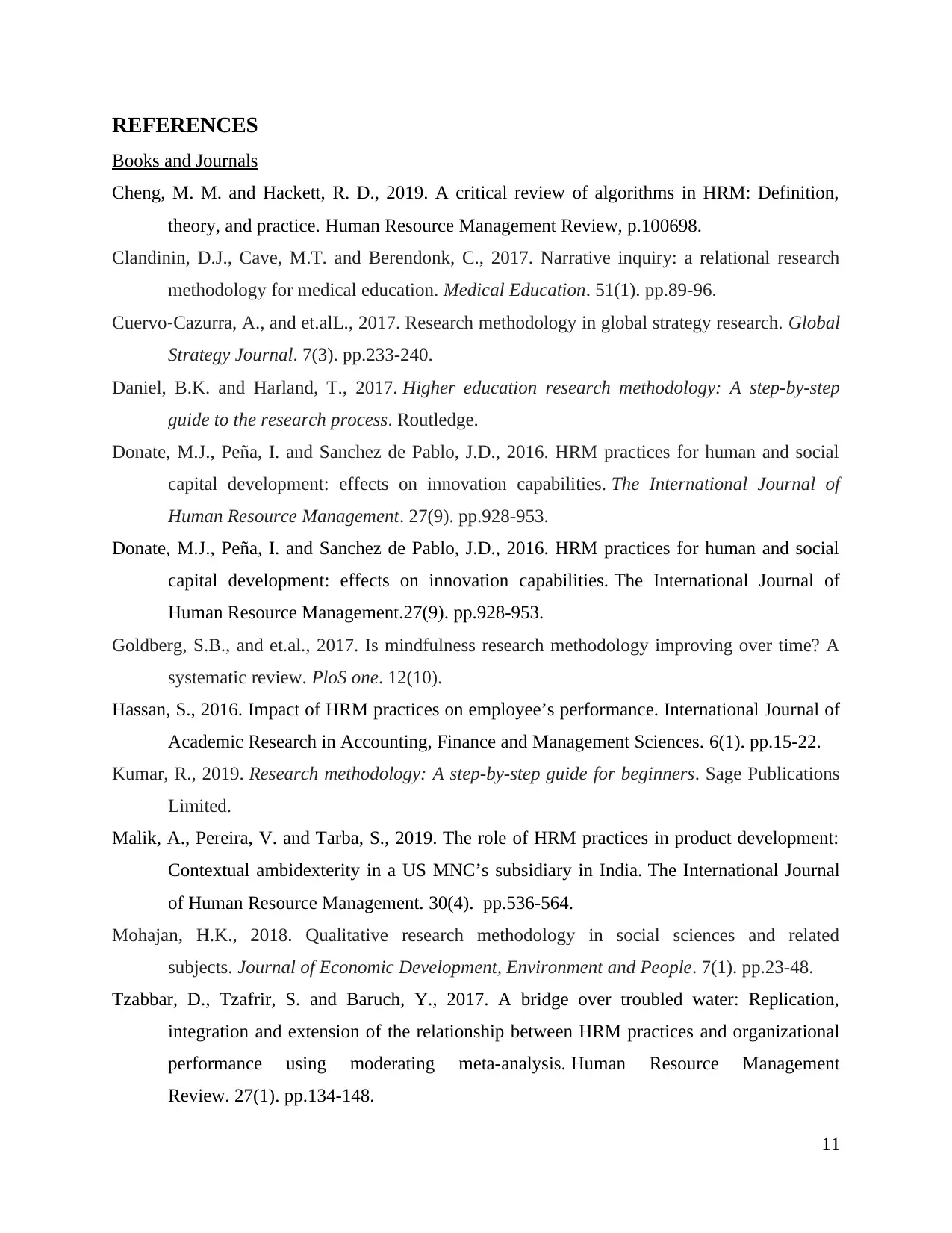
REFERENCES
Books and Journals
Cheng, M. M. and Hackett, R. D., 2019. A critical review of algorithms in HRM: Definition,
theory, and practice. Human Resource Management Review, p.100698.
Clandinin, D.J., Cave, M.T. and Berendonk, C., 2017. Narrative inquiry: a relational research
methodology for medical education. Medical Education. 51(1). pp.89-96.
Cuervo‐Cazurra, A., and et.alL., 2017. Research methodology in global strategy research. Global
Strategy Journal. 7(3). pp.233-240.
Daniel, B.K. and Harland, T., 2017. Higher education research methodology: A step-by-step
guide to the research process. Routledge.
Donate, M.J., Peña, I. and Sanchez de Pablo, J.D., 2016. HRM practices for human and social
capital development: effects on innovation capabilities. The International Journal of
Human Resource Management. 27(9). pp.928-953.
Donate, M.J., Peña, I. and Sanchez de Pablo, J.D., 2016. HRM practices for human and social
capital development: effects on innovation capabilities. The International Journal of
Human Resource Management.27(9). pp.928-953.
Goldberg, S.B., and et.al., 2017. Is mindfulness research methodology improving over time? A
systematic review. PloS one. 12(10).
Hassan, S., 2016. Impact of HRM practices on employee’s performance. International Journal of
Academic Research in Accounting, Finance and Management Sciences. 6(1). pp.15-22.
Kumar, R., 2019. Research methodology: A step-by-step guide for beginners. Sage Publications
Limited.
Malik, A., Pereira, V. and Tarba, S., 2019. The role of HRM practices in product development:
Contextual ambidexterity in a US MNC’s subsidiary in India. The International Journal
of Human Resource Management. 30(4). pp.536-564.
Mohajan, H.K., 2018. Qualitative research methodology in social sciences and related
subjects. Journal of Economic Development, Environment and People. 7(1). pp.23-48.
Tzabbar, D., Tzafrir, S. and Baruch, Y., 2017. A bridge over troubled water: Replication,
integration and extension of the relationship between HRM practices and organizational
performance using moderating meta-analysis. Human Resource Management
Review. 27(1). pp.134-148.
11
Books and Journals
Cheng, M. M. and Hackett, R. D., 2019. A critical review of algorithms in HRM: Definition,
theory, and practice. Human Resource Management Review, p.100698.
Clandinin, D.J., Cave, M.T. and Berendonk, C., 2017. Narrative inquiry: a relational research
methodology for medical education. Medical Education. 51(1). pp.89-96.
Cuervo‐Cazurra, A., and et.alL., 2017. Research methodology in global strategy research. Global
Strategy Journal. 7(3). pp.233-240.
Daniel, B.K. and Harland, T., 2017. Higher education research methodology: A step-by-step
guide to the research process. Routledge.
Donate, M.J., Peña, I. and Sanchez de Pablo, J.D., 2016. HRM practices for human and social
capital development: effects on innovation capabilities. The International Journal of
Human Resource Management. 27(9). pp.928-953.
Donate, M.J., Peña, I. and Sanchez de Pablo, J.D., 2016. HRM practices for human and social
capital development: effects on innovation capabilities. The International Journal of
Human Resource Management.27(9). pp.928-953.
Goldberg, S.B., and et.al., 2017. Is mindfulness research methodology improving over time? A
systematic review. PloS one. 12(10).
Hassan, S., 2016. Impact of HRM practices on employee’s performance. International Journal of
Academic Research in Accounting, Finance and Management Sciences. 6(1). pp.15-22.
Kumar, R., 2019. Research methodology: A step-by-step guide for beginners. Sage Publications
Limited.
Malik, A., Pereira, V. and Tarba, S., 2019. The role of HRM practices in product development:
Contextual ambidexterity in a US MNC’s subsidiary in India. The International Journal
of Human Resource Management. 30(4). pp.536-564.
Mohajan, H.K., 2018. Qualitative research methodology in social sciences and related
subjects. Journal of Economic Development, Environment and People. 7(1). pp.23-48.
Tzabbar, D., Tzafrir, S. and Baruch, Y., 2017. A bridge over troubled water: Replication,
integration and extension of the relationship between HRM practices and organizational
performance using moderating meta-analysis. Human Resource Management
Review. 27(1). pp.134-148.
11
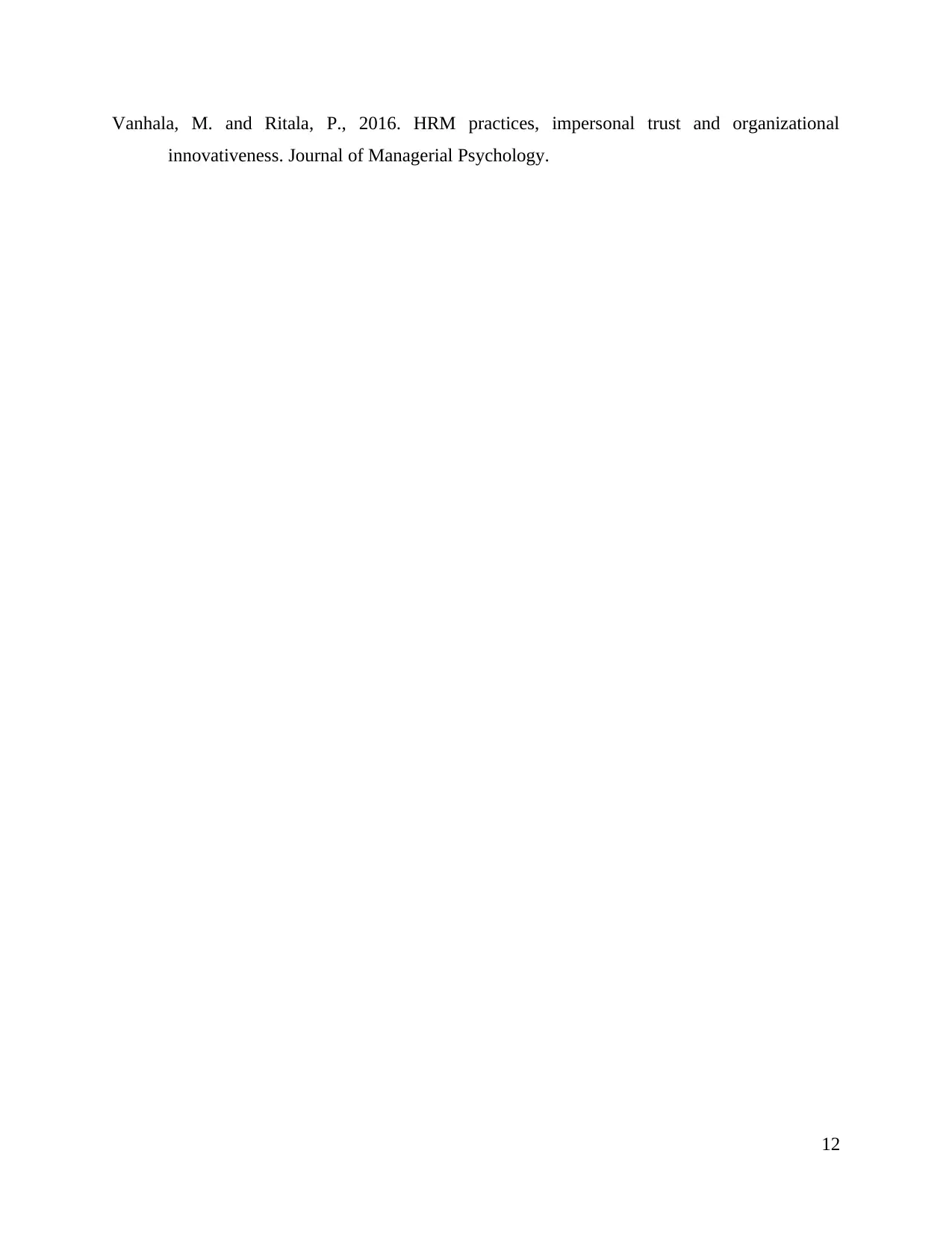
Vanhala, M. and Ritala, P., 2016. HRM practices, impersonal trust and organizational
innovativeness. Journal of Managerial Psychology.
12
innovativeness. Journal of Managerial Psychology.
12
⊘ This is a preview!⊘
Do you want full access?
Subscribe today to unlock all pages.

Trusted by 1+ million students worldwide
1 out of 12
Related Documents
Your All-in-One AI-Powered Toolkit for Academic Success.
+13062052269
info@desklib.com
Available 24*7 on WhatsApp / Email
![[object Object]](/_next/static/media/star-bottom.7253800d.svg)
Unlock your academic potential
Copyright © 2020–2025 A2Z Services. All Rights Reserved. Developed and managed by ZUCOL.





